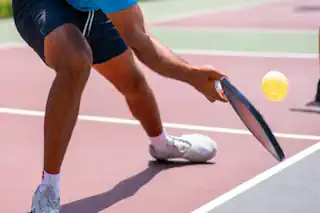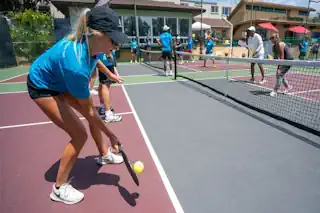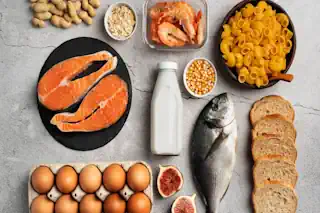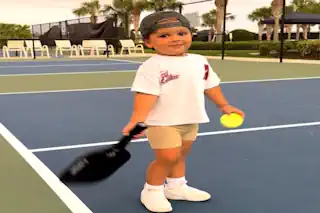The Ultimate Beginners Guide to Serving in a Pickleball Game
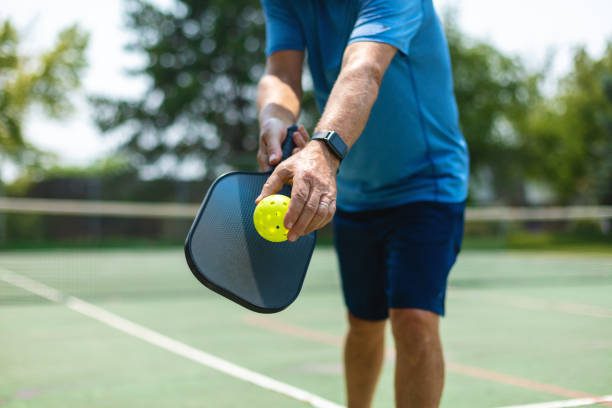
Introduction to the Serve in Pickleball
Serving in pickleball, much like in any other sport, is the gateway to the game. It’s the first opportunity to set the tone, dictate the pace, and potentially earn your team a point. The serve is where it all begins, and understanding its nuances is crucial for any pickleball player, whether you’re just starting or looking to refine your game.
In this comprehensive guide, we are going to explore every facet of serving in pickleball. We’ll start with the basics and move on to help you master your technique, strategize effectively, and avoid those pesky common mistakes. By the end, you’ll have all the tools you need to elevate your serving in pickleball to a whole new level.
Basic Rules of Pickleball Serving
Understanding the Rules and Regulations
Pickleball serving rules are fairly straightforward. The server must stand behind the baseline and serve the ball diagonally to the receiver’s service court. The serve must be underhand and must clear the non-volley zone, commonly known as ‘the kitchen.’
Players alternate serving and the first server is determined by a coin toss. Partners cannot choose who serves first; this alternates between partners and changes every time a point is scored.
Official Rules for a Pickleball Serve
When serving in pickleball, it’s essential to be familiar with the official rules to ensure fair play. Here is a list of the key regulations that every pickleball player should know:

- Service Motion: The serve must be made with an underhand motion. The arm must be moving in an upward arc, with the paddle contacting the ball below waist level.
- Serve Position: The server must have both feet behind the baseline and within the imaginary extension of the center-line and sideline. The serve must be initiated from the right-hand service court when the server’s score is even and from the left when the score is odd.
- Two-Bounce Rule: After the serve attempt, each team must play their first shot off the bounce. That is, the receiving team must let the serve bounce before returning, and the serving team must also let the return bounce before playing it. After these two bounces have occurred, the ball can be volleyed or played off the bounce.
- Diagonal Serve: The serve must be directed diagonally to the opponent’s service court or opposing team. If it lands in, it is considered a good serve. If it lands outside the service court or in the non-volley zone (‘the kitchen’), it is a fault.
- Non-Volley Zone Rule: The serve must clear the non-volley zone. Any serve landing in ‘the kitchen’ or on the non volley zone line is considered a fault.
- Service Sequence: Players serve in turn, and, in doubles, service alternates between teams and teammates. The first serve of a new game is made from the right-hand court. If a point is scored, the server switches sides and the server continues serving from the left-hand court. Service continues to alternate sides for each point scored. Only one serve attempt is permitted on each side of the pickleball court.
- Faults: A serve is considered a fault if it touches the net (even if it lands in the correct service court), goes out of bounds, or lands in the non-volley zone. A fault results in a loss of serve.
Different Types of Serves
There are various types of serves in pickleball that players can utilize:
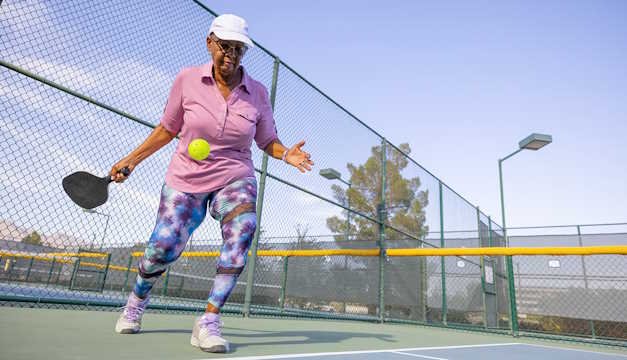
- The Power Serve: A fast, low serve that bounces close to the non-volley zone, making it difficult for the receiver to return.
- The Lob Serve: A high-arching, defensive serve that forces the receiver to step back, giving the serving team good court positioning.
- The Slice Serve: A serve with side-spin that curves when it bounces, making it harder for the receiver to anticipate the direction of the ball.
- The Soft or Drop Serve: A serve that’s hit softly and lands just over the net, forcing the receiver to move forward quickly and making an aggressive return challenging.
- The Volley Serve: This involves hitting the ball before it bounces, typically executed close to the baseline to generate a quick, aggressive start to the rally. While not officially recognized in traditional pickleball rules, it’s a variation seen in casual play that challenges the receiver to react swiftly.
Each serve has its own purpose and can be used strategically depending on the game situation.
Mastering the Serve
Techniques for Improving Your Serve
A smooth, accurate, and consistent serve is a product of good technique. Here are some key tips to improve your pickleball serve:
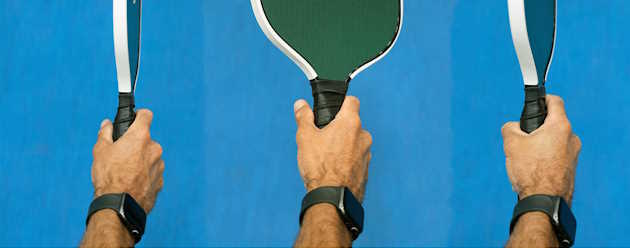
- Grip: Your grip on the pickleball paddle should be comfortable, typically the continental grip, allowing for a broad range of strokes and spins.
- Positioning: Start with your feet shoulder-width apart and slightly staggered for balance, with most of your weight on your back foot.
- The Swing: The pickleball serve follows an arc similar to shaking hands with someone, ensuring an underhand swing. Your paddle should make contact with the ball at the waist level.
- Contact point: The ideal contact point for the ball is slightly in front of the body, allowing for better control and power.
Practice Drills for Beginners and Advanced Players
For beginners, it’s important to start with the basic underhand serve. Practice hitting the ball consistently into the correct court, focusing on accuracy before power. Advanced players can work on varying their serves and even experimenting with spin.
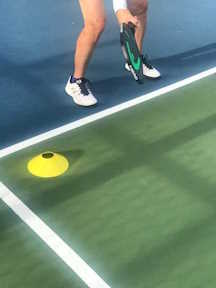
Here are a few practice drills to help you work on serving:
- The Target Drill: Set up targets on the serving court and practice hitting the ball into those targets consistently.
- The Service Sequence Drill: Practice serving within a sequence of different serves to improve variety and strategy.
- The Return Drill: Have a partner return your serves to practice different serve and return scenarios.
Strategies for Effective Serving
Importance of Strategic Serving in Game Play
Serving strategically can give you a significant advantage in a match. It involves reading your opponents, understanding their weaknesses, and playing to your strengths.
- Know Your Opponents: Pay attention to how your opponents are positioned and where they tend to struggle with their returns.
- Use Variations: Mix up your serve types to keep the returner guessing and off-balance.
- Positioning: After serving, quickly move into an optimal position, close to the non-volley zone, ready to capitalize on the return.
Tips for Serving Placement and Variations
Beyond just hitting the ball over the net, it’s important to place your serves in strategic areas to control the point. Here are some tips to improve your serves:
- Deep Serves: Serves that land near the baseline can be hard to return because they give the receiver less time to prepare their shot.
- Sideline Serves: Serves aimed at the sideline can force the receiver to make a wider return, potentially opening up the court for you and your partner.
- Body Serves: Occasionally serving toward the body of the receiver can catch them off guard, especially if they are waiting for a serve to the backhand or forehand side.
Utilizing Slice and Spin in Your Serve
Mastering the art of applying slice and spin to your serves can drastically change the game’s dynamics, adding unpredictability and challenge for your opponents. Slice and spin serves can be formidable tools in a player’s arsenal, creating serves that are not only difficult to return but also setting the tone for offensive game play.
- The Slice Serve: To execute a slice serve, you need to strike the ball in a way that your pickleball paddle brushes against it from a high to low motion, imparting lateral spin. This type of serve causes the ball to skid and stay low upon bouncing, making it tricky for the opponent to make a solid return.
- The Spin Serve: Spin serves generally refer to topspin serves where the ball rotates forward rapidly, causing it to dip faster than expected. To achieve this, hit the ball with an upward motion, using the lower part of the ball. This serve is effective for pulling your opponent out of position as the bounce is unpredictable and can vary in height significantly.
Both slice and spin serves require practice to master the right amount of touch and power. Players should experiment with different angles and speeds to see how the ball reacts upon hitting the court. It’s also crucial to observe your opponent’s response to these serves to adjust your strategy accordingly. Incorporating these serves into your game not only enhances your serving skills but also adds a strategic layer to your game play, making you a more versatile and challenging opponent.
Common Serving Mistakes to Avoid
Errors to Watch Out for When Serving
Understanding what not to do is just as important as learning what to do when serving in pickleball. Common serving mistakes include:
- Hitting the serve too high, which gives the receiver plenty of time to prepare their return.
- Contacting the ball too late and too low, resulting in a serve that clips the top of the net or falls short.
- Over-reliance on power, which can sacrifice control and consistency.
- Make sure to strike on the paddle head and not the side or grip of the pickleball paddle.
How to Correct Common Serving Mistakes
- Work on Timing: Practice your serve timing, ensuring you make contact with the ball at the peak of your swing for optimal power and accuracy.
- Vary Your Serves: Don’t get stuck in a routine – mix up your serves to keep opponents on their toes and to enhance your game’s depth.
- Get Feedback: Recording your serves or having a coach provide feedback can be invaluable for spotting and correcting mistakes.
Official Serving Rules in Pickleball
Understanding and adhering to the official serving rules are crucial for every pickleball player, from beginners to advanced. Here are the categories from the official USA Pickleball Official Rulebook (2024):
- 4.A. Serving – General overview of the serving rules
- 4.B. Player Positions – Where the players have to stand during the serve
- 4.C. Readiness – Players must be ready to serve and receive
- 4.D. Calling the Score – Server only unless there is a voice impairment
- 4.E. 10 – Second Rule – Must serve within 10 seconds after calling the score
- 4.F. Scoring – Points are only scored when serving
- 4.G. Points – Points are scored by serving the ball and winning the rally
- 4.H. Winning the Game – First team to score the winning point (usually 11)
- 4.I. Calling the Score in Singles Matches – Proper sequence for calling the score in singles play
- 4.J. Calling the Score in Doubles Matches – Proper sequence for calling the score when serving doubles team
- 4.K. Wrong Score Called – Play can be stopped if the wrong score is called
- 4.L. Service Foot Faults – Feet must be out or you lose the serve
- 4.M. Service Faults – Basically, the ball can’t hit anything and must land in the appropriate area
- 4.N. Receiver Faults – Wrong person hits or gets hit by the ball
There is a lot of detail in some sections of these rules. More detail than is permitted in this article at this time. If you would like to review the official rules they are available from the USA Pickleball organization. Here is the link to the official rules – USA Pickleball Official Rules (2024)
Conclusion
Serving in pickleball is more than just the start of the game; it’s an art that can influence the outcome of the match. By practicing different serve types, perfecting your technique, and applying strategic serving tactics, you can significantly enhance your pickleball performance.
Remember, the key to serving success is consistency and control. Start with the basics, hone your technique through regular practice, and constantly challenge yourself to improve. With dedication and the right approach, you’ll be acing those serves in no time.
Keep serving, keep learning, and most importantly, keep enjoying the exhilarating sport of pickleball. The adventure of each serve is a learning moment and a chance to put your opponents on the defensive. Welcome to a world where every serve could be the start of a winning play.
Serving sequence changes with every rule violation. Be sure the server initiates in the right place with drop serves or bounce serves. Pay special attention to the two bounce rule or double bounce rule. I get excited and often forget the two bounce rule and end up volleying the serve and then a fault occurs.
Frequently Asked Questions (FAQ)
Q1: Can I perform both slice and spin serves in a single game?
A1: Absolutely! Mixing slice and spin serves within a game can be a highly effective strategy. It keeps your opponent guessing and can disrupt their return rhythm.
Q2: How can I practice my serves more effectively?
A2: Practice serves by targeting specific areas of the court and varying your serve types. Use cones or markers to define targets. Recording your serving sessions and getting feedback from a coach or experienced player can also offer valuable insights into areas of improvement.
Q3: What are the most common serving faults in pickleball?
A3: Some common serving faults include foot faults (stepping on or over the baseline), hitting the ball out of bounds, and failing to hit the ball over the net. Ensuring that serves land within the correct service box on the correct side of the court is crucial.
Q4: How do I fix a serve that consistently goes too high?
A4: Serving too high often results from hitting the ball too forcefully without sufficient control. Focus on hitting the ball with more of a brushing motion rather than a hard smack. Also, practice regulating the power behind your serve to find a balance that keeps the ball lower.
Q5: Is there a penalty for calling the wrong score?
A5:If the wrong score is called, the serving team must correct the mistake before the serve is made. If the ball is served after calling an incorrect score, the serve is considered a fault, and service passes or the receiving team gains the serve.
Q6: Can I serve before the receiver is ready?
A6: According to official rules, the receiver must be ready before the serve is made. However, if the receiver attempts to return the serve, they are deemed to have been ready.
Q7: How can I improve my serve’s placement and accuracy?
A7: Improving placement and accuracy revolves around consistent practice with a focus on form and technique. Aiming for specific targets during practice sessions and gradually increasing the difficulty of these targets can enhance your serve’s placement and accuracy over time.
Remember, mastering the art of serving in pickleball takes patience, practice, and perseverance. Keep refining your technique, and don’t be afraid to experiment with different serving styles to find what works best for you and your game strategy.
